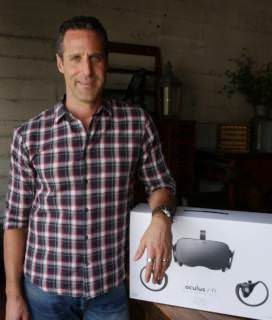Def Jam Recordings has brought on Scott Greer as executive vice president of marketing and commerce, where he will lead the company’s marketing, branding and creative content initiatives.
“Now more than ever, we are seeing the global reach of that culture, and Def Jam is rightfully at its center,” Greer said. “Authenticity and cutting-edge artistry have always been at the core of Def Jam’s spirit, and its incredible roster includes some of the most influential voices and exciting new trailblazers in music today.”
Greer joins the label after a six-year tenure as senior vice president of marketing for Columbia Records, where he worked on campaigns for Adele, Beyonce, Katy Perry, Lil Yachty and many others.
Manufacturer Daimler Trucks North America (DTNA) is promoting David Giroux internally to the newly created position of director of channel marketing. Giroux will head communication and strategy for DTNA’s Detroit and Freightliner brands. Filling the now-vacant position of director of public relations and corporate communications is Katja Bott.
“David’s accomplishments for DTNA are tremendous. For over six years, he and his team have ensured industry leading communications. We are grateful that he will continue to push communications for DTNA in this new critical role for the company,” said Roger Nielsen, president and CEO of DTNA. “We welcome Katja to the DTNA family. With her breadth and depth of public relations and leadership experience, she will continue leading communications in our industry.”
Giroux was DTNA’s director of communication for seven years, and Bott has served at the Daimler Goup for 14 years.
Packaged foods conglomerate Conagra Brands is bringing on DeLu Jackson to fill the new role of vice president of precision marketing. He will oversee transition to a more personalized consumer marketing approach using data-driven activations.
“DeLu has achieved incredible results as an integrated marketing leader and he will play a vital role in transforming our marketing function so that our brands are reaching consumers in the ways their connectivity and lifestyles dictate,” said Darren Serrao, executive vice president and chief growth officer. “As we focus on growing our brands and business, DeLu will help accelerate our progress by partnering with our teams involved with insights, innovation and marketing strategies to create breakthrough programs.”
Jackson most recently was vice president of digital acceleration for Kellogg Company, and before that was corporate vice president of global marketing at McDonald’s Corporation.
“Conagra Brands is transforming into a more contemporary company and with that comes opportunities to deploy more innovative marketing strategies for its brands,” Jackson said. “I’m looking forward to digging in and helping the team drive results and having a positive impact on Conagra’s growth objectives.”
Personal loan marketplace Credible.com has hired its first chief marketing officer Alan Gellman.
He will focus on building word-of-mouth marketing among consumers and stimulating further company growth.
“Credible has established that our core values of transparency, simplicity and choice are widely appreciated by millennials,” said Credible founder and CEO Stephen Dash. “We’re excited to welcome Alan to our team—we share a vision for doing the right thing by consumers, and Alan’s experience is both significant and highly relevant.”
Gellman previously held the position of CMO at online-centric insurance agency Esurance, where he was named one of the 50 most innovative CMOs in the world by Business Insider.
“Credible’s mission of helping consumers make smarter financial decisions is enormously appealing to me, and the opportunities for scaling the company’s business are exciting,” Gellman said. “The disruptive approach to student lending—where Credible provides clear choices and active guidance— has tremendous potential to extend to other financial services categories.”
Meelad Sadat is joining video game developer and publisher Blizzard Entertainment as director of global corporate communications. Sadat is jumping ship from virtual reality headset manufacturer HTC, where he was director of public relations for the Vive. Sadat previously served as the Ayzenberg Group’s communication’s director as well.
T-Mobile has promoted Andrew Sherrard to the newly created position of executive vice president and chief commercial officer. Sherrard, previously the brand’s CMO, will lead all offer and operations strategies for the company.
President Donald Trump has dissolved the economic advisory and manufacturing councils after numerous executives from brands like Under Armour and Intel resigned in protest of his remarks regarding the events in Charlottesville, Virginia this week.
Members of the two councils held leadership positions in firms such as JPMorgan Chase, IBM, Campbell Soup Co. and PepsiCo.
Angela Courtin has signed on to YouTube as global head of YouTube TV and originals marketing, joining recent hire Jon Wax (head of drama) and promotee Dustin Davis (head of comedy development).
Previously, Courtin worked at Fox Broadcasting as chief marketing officer, where she oversaw brand strategy and both on- and off-air promotion.
Mike Connolly has been hired by internet radio giant SiriusXM as their latest head of ad sales, where he will oversee attempts to grow revenue across the full lineup of SiriusXM channels.
“Mike is a proven ad industry executive and we are excited to have him lead SiriusXM’s ad sales team and continue its strong sustained growth,” said Scott Greenstein, president and chief content officer. “Mike’s extensive experience in audio entertainment will be of crucial importance to SiriusXM as our programming depth and variety expand and the national audience of subscribers and listeners continues to rise.”
Connolly joins SiriusXM from his previous position as vice president of advertising and affiliate sales for ESPN Audio Network.
“I’ve been a longtime listener of SiriusXM content and have always been a huge fan,” said Connolly. “A vast majority of my career has been in radio sales, so the opportunity to lead the sales effort at SiriusXM is a dream come true.”
Monumental Sports and Entertainment (MSE), owners of the Washington Wizards, Capitals and Mystics, have recruited Grant Paranjape as director of esports business and team operations. He will oversee their investment in Team Liquid, which recently won the Dota 2 tournament.
“We see esports as the next great frontier in sports and entertainment, and a crucial part of our larger strategic efforts to engage younger fans,” said Zach Leonsis, senior vice president and general manager. “In addition to launching two AFL teams, we are relentlessly building our esports business to meet this young, voraciously growing audience where they are—on digital and over-the-top platforms.”
Paranjape is joining Monumental from a previous position as business development lead at Splyce, where he contributed to improvements to their League of Legends team.
“MSE has been a visionary in working to develop a robust esports operation and I’m looking forward to working with the team here to further expand our esports practice,” Paranjape said. “With a history of innovation and technological experience, MSE’s focus on esports will allow our team to provide fans with industry leading content and an exceptional viewing experience.”
Kid’s media brand pocket.watch is bringing aboard Stone Newman as chief revenue officer, where he will oversee sponsorship and merchandising of the brand’s affiliated YouTube channels.
“Stone is what I would call a mythical CRO, an executive who can do it all from merchandising, to content sales, to cultivating sponsorship opportunities,” said Chris M. Williams, founder and CEO of pocket.watch. “He combines the right mix of big company experience, with a roll up your sleeves startup attitude, to help us achieve our goals during this explosive stage in our business.”
Newman joins pocket.watch from his previous role as president of global products licensing for Genius Brands International, where he negotiated the company’s first content sales to Nickelodeon and Netflix and secured a worldwide toy deal with Mattel.
“From the moment I was introduced to pocket.watch, I knew it was going to be a revolutionary business,” said Newman. “I never thought I’d say this, but being a father of toddler twin girls and a seven year old son, I can’t wait to bring my new work home to my kids.”
Music lifestyle company Gibson Brands has appointed its first global brand ambassador in Guns N’ Roses guitarist Slash. In the role, Slash will develop new products and provide exclusive content to the brand.
“We are thrilled to recognize Slash as Gibson’s first Global Brand Ambassador,” said Henry Juszkiewicz, chairman and CEO of Gibson Brands. “Slash embodies the characteristics of creativity, passion and excellence that are so closely aligned with Gibson and we are very proud of the friendship and mutual success we have shared together for over 30 years.”
Slash has used Gibson guitars throughout his 30-year rock career en route to selling 30 million albums.
“It’s an honor to be Gibson’s first Global Brand Ambassador,” said Slash. “I’ve been working with Gibson since the early days of my professional career and playing Gibson guitars since before that. I’m proud of the creative relationship we’ve developed over the years.”
The LEGO Group has appointed Niels B. Christiansen as CEO.
“Niels is a great leader who delivered outstanding results while CEO of Danfoss,” said Jørgen Vig Knudstorp, executive chairman of LEGO Brand Group. “His experience in digitalization and globalization, implementing a transformative strategy and creating an agile, high performing, international team will benefit the LEGO Group.”
Christiansen will be replacing Bali Padda, who will stay on in an advisory role once Christiansen joins the company in October. Christiansen comes off of a nine-year tenure as CEO of industrial technology company Danfoss, during which time the company doubled in value.
“I am honored to have the opportunity to join an organization as iconic and purpose-driven as the LEGO Group,” said Christiansen. “I have loved building with LEGO bricks since I was a child. As I look at the challenges facing this generation of children, the group’s mission, to inspire and develop the builders of tomorrow, is more important and urgent than ever.”
Netflix announced a multiyear television deal with writer and producer Shonda Rhimes and her production company Shondaland. She, along with her longtime partner and producer Betsy Beers will develop a new series exclusive to the streaming platform. This announcement comes on the heels of the news of Disney moving several of its properties off of Netflix to a planned proprietary streaming service, and is sure to shore up any concerns about new content available to subscribers. The streaming giant has also been steadily growing more autonomous of late, partnering less with studio producers and offering showrunners more control over their projects than at larger media conglomerates.
Rhimes’ current shows Grey’s Anatomy, Scandal and How to Get Away with Murder will continue to air on ABC.
“Shonda is one of the greatest storytellers in the history of television,” said Ted Sarandos, Netflix’s chief content officer. “Her work is gripping, inventive, pulse-pounding, heart-stopping, taboo-breaking television at its best. I’ve gotten the chance to know Shonda and she’s a true Netflixer at heart—she loves TV and films, she cares passionately about her work and she delivers for her audience.”
Rhimes has led her company Shondaland for 12 years, starting with Grey’s Anatomy in 2005 and continuing on to produce six more shows, of which four are still on the air.
“Shondaland’s move to Netflix is the result of a shared plan Ted and I built based on my vision for myself as a storyteller and for the evolution of my company,” said Rhimes. “He understood what I was looking for—the opportunity to build a vibrant new storytelling home for writers with the unique creative freedom and instantaneous global reach provided by Netflix’s singular sense of innovation.”
(Editor’s Note: This post will be updated daily until Friday, August 18. Have a new hire tip? Let us know at editorial@alistdaily.com.)
Job Vacancies
| Sr. Brand Manager |
Trion Worlds |
Redwood City, CA |
| Sr. Public Relations Manager |
Trion Worlds |
Redwood City, CA |
|
|
Trion Worlds |
Redwood City, CA |
| VP, Brand Marketing |
TOMS |
Los Angeles, CA |
| Director, Marketing |
Sony Music Entertainment |
New York, NY |
| Director, Brand Management |
Warner Music Group |
Nashville, TN |
| Director, Strategic Partnership Marketing |
NBC Universal |
Universal City, CA |
| Director, Talent Strategy & Influencer Marketing |
Disney |
Glendale, CA |
Make sure to check back for updates on our Jobs Page.

 We frequently update our backers with progress, showing them new art and animation whenever we can. We do this through streaming, campaign updates and the occasional trailer when there’s a bigger announcement. Soon we’re going to take the next step and give players a build to play with so they can start directly providing feedback on the game. This will be an enhanced version of the build we featured at E3 and Anime Expo. Once it’s out there, it’ll serve as a lasting test bed so we can try out new gameplay changes and get feedback. Eventually we intend to test out new characters and levels. Finally—in what I believe to be a first—the build will not only be delivered on PC, but also the PlayStation 4 and Xbox One. We’re extremely grateful to Sony and Microsoft for letting us do this.
We frequently update our backers with progress, showing them new art and animation whenever we can. We do this through streaming, campaign updates and the occasional trailer when there’s a bigger announcement. Soon we’re going to take the next step and give players a build to play with so they can start directly providing feedback on the game. This will be an enhanced version of the build we featured at E3 and Anime Expo. Once it’s out there, it’ll serve as a lasting test bed so we can try out new gameplay changes and get feedback. Eventually we intend to test out new characters and levels. Finally—in what I believe to be a first—the build will not only be delivered on PC, but also the PlayStation 4 and Xbox One. We’re extremely grateful to Sony and Microsoft for letting us do this.


